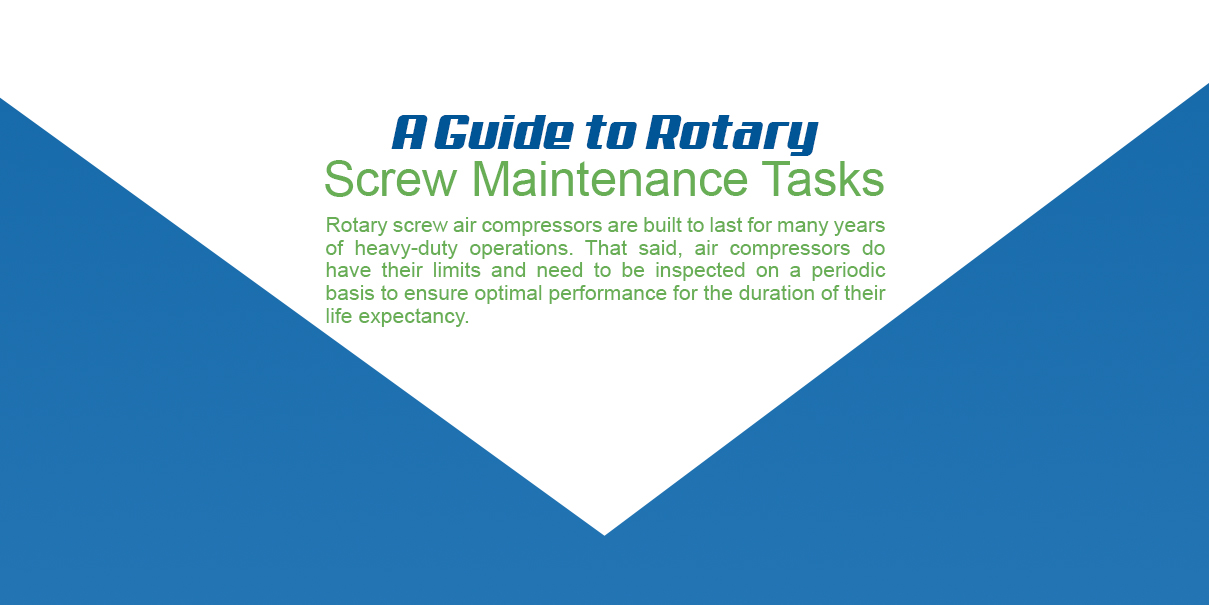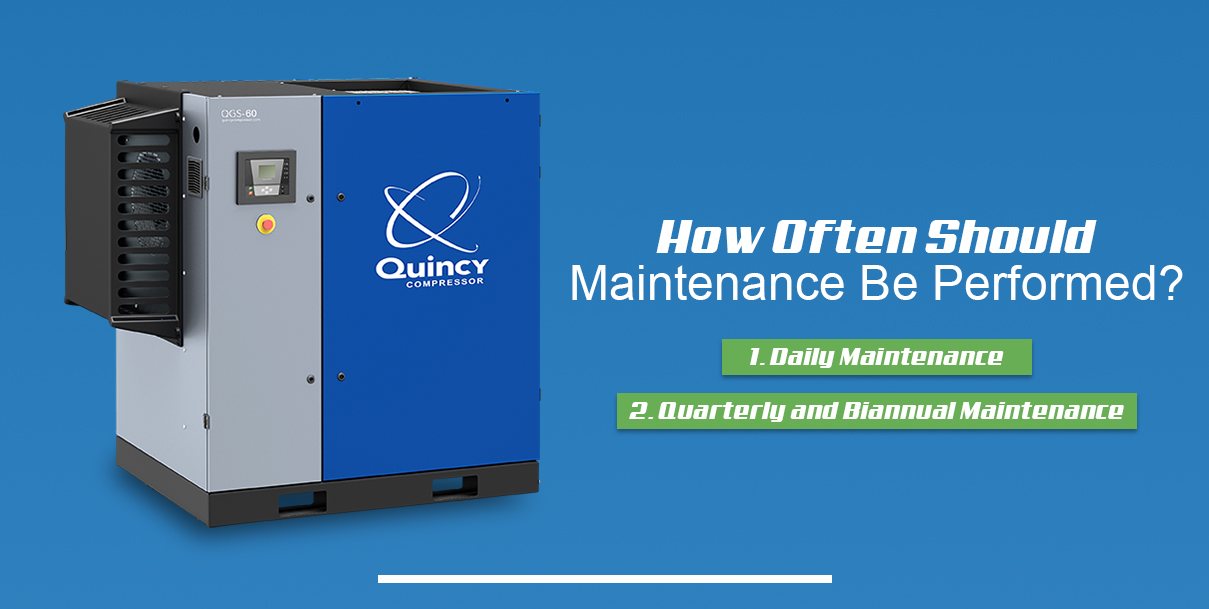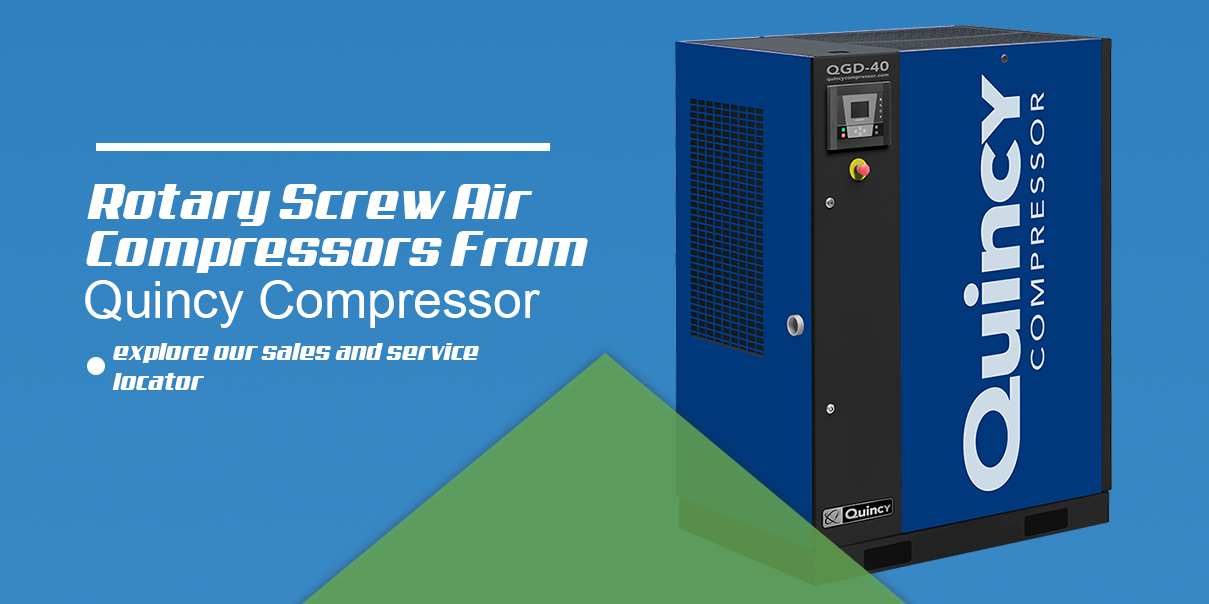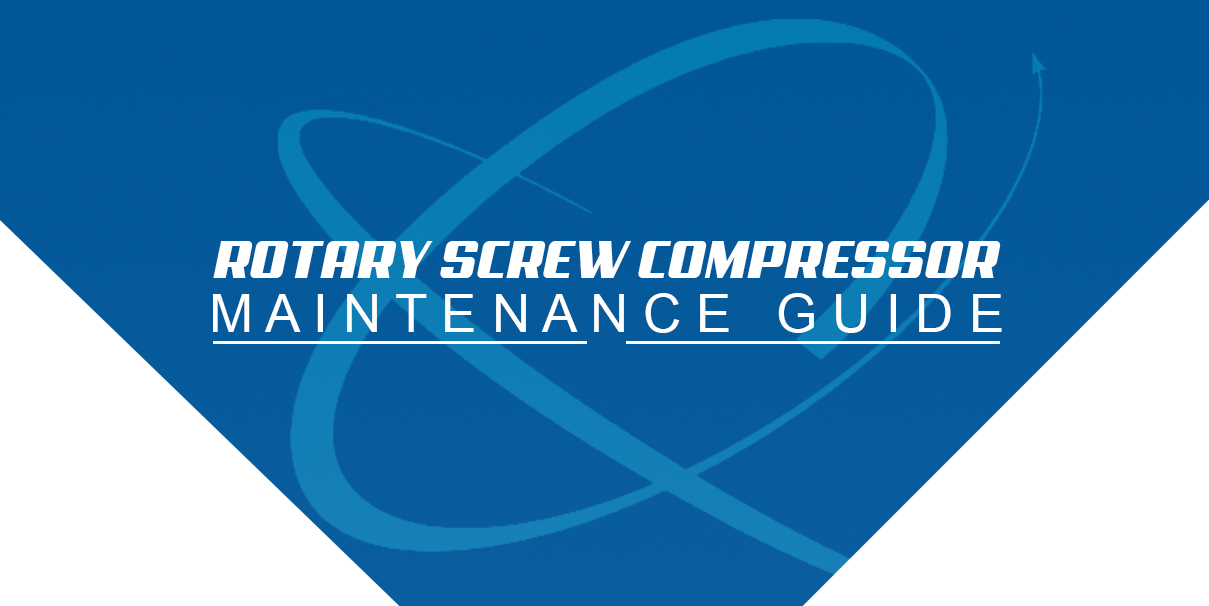
Of all the different types of air compressors on the market, rotary screw models are generally simple in design and relatively easy to maintain through many years of service life. As such, rotary screw air compressors are used for operations of all sizes, from the largest of manufacturers to private, one-person operations. When well-maintained, a rotary air compressor can provide thousands of hours of unimpeded performance.
Why Regular Maintenance of Your Rotary Screw Compressor Is Important
Like all compressor types, rotary screw models do require periodic maintenance. Thanks to the simplicity of the internal components, maintenance is relatively easy on most rotary air compressors. As long as you stick to a rotary screw compressor maintenance schedule, you will likely be rewarded with many, many years of optimal productivity from your machine.
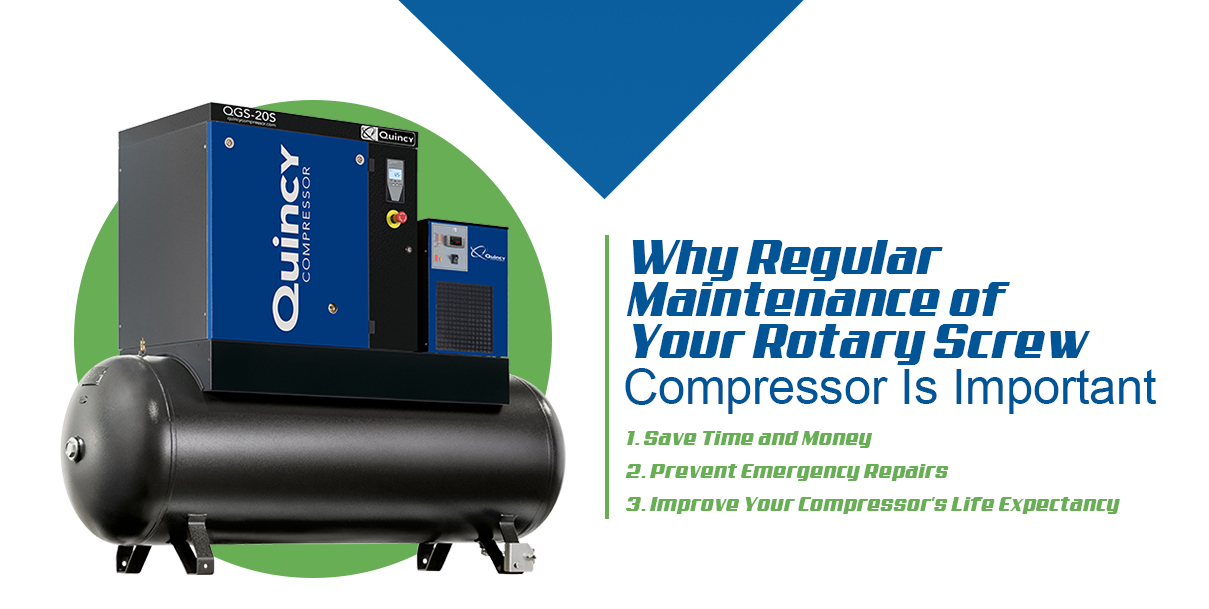
1. Save Time and Money
When you stick to a screw compressor maintenance schedule, you reduce the risk of system downtime at unexpected intervals. With routine checkups, you can spot potential problems the moment they arise, before they get out of hand and grow into more serious issues. The earlier you identify a problem, the easier and less costly it is to remedy. In many cases, a problem detected early can be rectified in a few minutes with no money spent.
Routine maintenance also saves time in the long run. In any industry, system downtime is costly and time-consuming. The time that a compressor remains down and inoperable is productivity lost. Even just a few hours of downtime can result in untold losses. With regular air compressor maintenance, you lower the risk of costly downtime.
2. Prevent Emergency Repairs
One of the biggest risks of an irregular air compressor maintenance schedule is the chance of sudden, unexpected emergencies. If you only inspect your compressor on occasional, irregular intervals, you are not keeping track of how it performs on the inside. Even if the compressor seems fine on the outside and was purchased within the past few years, there could still be internal issues taking root that you are liable to miss if you only perform inspections on an infrequent, irregular basis.
In a worst case scenario, your compressor might stop functioning for reasons that could be hard to pinpoint. Consequently, a diagnosis could be even more time-consuming and costly. With consistent, periodic maintenance, you can pinpoint issues early and have them remedied almost immediately.
3. Improve Your Compressor’s Life Expectancy
When you stick to a rotary screw air compressor maintenance schedule, you can extend the compressor’s life expectancy. Over the years that you use the machine, you could ultimately get a better return on your initial investment by inspecting the compressor on a regular basis. As with any motorized machine, an air compressor will generally last longer when it is well-maintained and inspected according to a strict schedule.
Routine maintenance can also help you turn your initial investment into an enormous return. If and when the time comes that you finally replace the machine with a newer model, the old compressor will have likely yielded a fortune regarding productivity.
A Guide to Rotary Screw Maintenance Tasks
Rotary screw air compressors are built to last for many years of heavy-duty operations. That said, air compressors do have their limits and need to be inspected on a periodic basis to ensure optimal performance for the duration of their life expectancy.
A rotary air compressor consists of several key internal components that could wear down over time if you don’t give them due, timely inspections. Chief among these parts are the airend and the drive train, which respectively pressurize the air and drive the mechanisms of the air compressor. It is also important to inspect the motor and filters on a periodic basis and replace the lubricants when necessary.
1. Airends
Of all the components that comprise a rotary screw air compressor, the airend is the most crucial because this is where the pressurization of air takes place. While an airend can generally last for at least 40,000 hours, it can malfunction before its time if not properly maintained. An airend can be damaged by extreme system heat, dirty fluid and contamination.
To prevent the development of damaging conditions, you must inspect the airend on a periodic basis. Check for the following issues during each inspection of the airend in your rotary screw air compressor:
- Overheating: While the airend is built to withstand its share of heat, system issues can sometimes push the temperature beyond the acceptable threshold. Monitor the air compressor’s heat level on a regular basis to ensure that the internal components are not fielding too much heat.
- Improper lubrication: As with any internal moving mechanism, an airend can wear down without sufficient lubrication. Friction between poorly lubricated metal parts can generate excess heat and set off a chain of problems.
- Condensation: If you don’t drain the air compressor drip tray on a daily basis, condensation can spread throughout the internal components and cause system problems. Condensation can also be an issue if the air compressor lacks sufficient ventilation, especially if operated in subzero or humid conditions.
- Corrosion: If corrosion or rust develop on the airend or any adjacent component of an air compressor, the machine has obviously not been sufficiently maintained, lubricated and drained. Corrosion forms when the surfaces of metal parts absorb moisture or face internalized friction due to inadequate lubrication.
- Over-pressure: If the air compressor exerts too much pressure just to operate at regular levels, the parts within have lost their ability to function as normal. An airend could be forced to overexert itself if the machine grinds and overheats due to lack of lubricants.
- Incorrect control adjustment: In some cases, an airend will wear out at an accelerated pace due to improper settings. Operators who oversee this area should all be versed in the proper settings of a given air compressor and monitor these settings on a daily basis.
- Vibrations: If an air compressor makes unusual vibrations, the internal parts are probably enduring excess strain. Strange vibrations should serve as a red flag that the compressor needs to be shut off and inspected for airend issues as soon as possible.
- Oil seal leaks: If the oil leaks, the air compressor will be drained of the fluid that the mechanisms need to operate properly. Oil leaks result in more than just wasteful fuel consumption as they lead to mechanical friction and system overheating. If you spot an oil leak, shut off the compressor and inspect the issue immediately.
- Bearing noise: Just as with vibrations, strange and unusual noises from an air compressor should serve as a red flag that something is wrong with the internal mechanisms. In a rotary screw air compressor, an unusual noise will typically be the result of worn airend bearings. Pay particular attention to oil leaks and strange noises from the motor bearings as these are the two main indicators of imminent problems with an air compressor.
2. Drive Train
In a rotary screw air compressor, the drive train is the component that guides the motion of the internal mechanisms as a whole. Therefore, the drive train must have correct alignment at all times for the air compressor to function with optimal consistency. Moreover, the gear drives must be freshly lubricated on a periodic basis to ensure smooth running at all times. When you inspect the drive train, check for the following symptoms:
- Poor alignment: If the drive train is out of alignment, it won’t be capable of driving the motions of the air compressor with proper consistency. A poorly aligned drive train can cause system stress that could lead to premature failure of the motor bearings. An ill-aligned drive train can also take its toll on the airend.
- Worn belt: For the drive train to move at a proper pace, the belt must be in optimal working condition. If the belt becomes worn or frayed, it won’t have sufficient tension. Each time you inspect the belt tension, check for frayed ends and cracks.
- Insufficient lubrication: Lubrication makes internal mechanisms turn around and around with smoothness and consistency. If the lubricants are old or spoiled, the drive train is liable to be a source of friction within the compressor.
- Improper belt tension: The tension of the belt is critical to the moving operations of a rotary screw air compressor. If the tension is off, the machine can be rendered inefficient as it overworks to maintain an even pace. Ideally, the tension of the belt should be inspected every 500 hours and adjusted if necessary.
Overall, the drive train should be inspected every other month to ensure that the belt remains intact and properly adjusted and that the lubricant maintains proper viscosity.
3. Motor
To ensure proper motor health with your air compressor, make sure that the operating area is sufficiently ventilated during usage hours. To prevent overloading, keep track of the ampere draw. Most importantly, make sure that the motor bearings are properly lubricated during each inspection. Some of the biggest problems with rotary air compressor motors result from the following problems:
- Insufficient grease: If grease is inadequately applied to the bearings, the motor is deprived of necessary lubrication. This can lead to friction between metal parts that will cause the system to overwork itself and generate excess heat in the process.
- Hardened grease: In colder working environments, grease can harden and lose its proper viscosity. This denies the internal mechanisms of the lubrication needed for parts to run smoothly. In worst-case scenarios, grease can freeze in subzero temperatures and become sludgy when temperatures rise back to normal.
- Melted grease: In hot working environments, grease can lose its viscosity in the opposite way and become runny and ineffective as a lubricant. Under intense heat, grease can melt away and leave the metal parts of the motor unprotected. Grease can melt even more easily if it lacks proper viscosity for the application at hand.
- Wrong grease: Certain machines and working environments call for certain types of lubrication. If you lubricate your air compressor with grease of the wrong grade, it won’t offer the necessary protection against internalized mechanical friction, especially not under extreme temperatures.
- Mixed greases: Greases are not made to be mixed with one another. When you apply a new coat of grease, remnants of the last application of grease should be wiped away from the parts in question. The old grease could have acidic elements that might contaminate the new grease and ruin its effectiveness.
- Over-greased parts: If the bearings of the motor are over-greased, it could render them incapable of moving properly because the grease would function more as a coat of molasses than an actual lubricant. To keep your bearings running smoothly, make sure that fresh applications of lubricant go neither below or above the recommended amount.
Without the right grade of grease in proper proportions, the metal bearings of a rotary compressor are left to grind against one another with every revolution of the motor.
4. Filters
In addition to the air/oil separator, a rotary screw air compressor contains two other filters — the oil filter and the inlet filter. Each of these filters must be inspected on a periodic basis to ensure optimal filtration and to prevent the spread of dirt and oily mist throughout the system. Ideally, you should check the inlet filters after every 2,000 hours of operation. You should inspect the fluid filters every 1,000 hours. Filter maintenance helps to spare the system of the following problems:
- Airend wear: A dirty filter can have many adverse effects on the airend. The dirt from a clogged filter can pass through an air compressor and diminish the quality of the pressurized air. A dirty filter also deprives the system of proper ventilation.
- Component contamination: As unfiltered dirt and oil spread to other parts of the air compressor, problems are liable to ensue with different components as dust collects on oily and moisture-laden surfaces.
- Oil contamination: Poor filtration can dirty up the oil and grease within an air compressor, reducing the quality of lubrication and rendering the system more vulnerable to breakdowns.
- System overheating: When an air compressor lacks sufficient inlet filtration, system overheating could result from the accumulation of air-bound particles. The hotter the mechanisms become, the shorter the service life between each round of maintenance.
- Reduced air quality: Poor filtration has a detrimental effect on the quality of end-point applications because the outbound pressurized air is rendered dusty, oily and watery.
When the filters are allowed to accumulate dirt, an air compressor could lose its ability to fulfill its purposes.
5. Lubricants
In a rotary screw air compressor, the oil supply is vital to the health of the system. Oil allows for clean and easy movement between the various parts that drive the pressurization of incoming air. In doing so, oil keeps the air compressor cool through many hours of heavy-duty operation.
For the oil to do its job properly, you must change the oil supply on a periodic basis. Sample the oil every two or three months to ensure that it retains the right color and consistency. Once the level drops, clean out the old oil and refill. It is important not to mix old and new oils because the former could have contaminants that would infect subsequent oil supplies. Overall, you must prevent the following conditions from taking hold of the oil in your air compressor:
- Leaky oil: If the oil leaks, the air compressor is being deprived of vital fluid. An oil leak could be indicative of a crack in the oil compartment or an ill-fitted connecting fastener.
- Acidic or contaminated oil: If an oil supply is left to linger past its freshness, the oil is liable to develop acidic qualities, especially if it comes into contact with moisture, dirt or rust.
- Runny oil: Oils are sold at certain grades with specific viscosities. If the oil in your air compressor loses its viscosity, it ceases to function as an effective oil for the mechanical components inside the machine. Runny oil is about as effective as water when it comes to parts lubrication.
- Mixed oil: The oil in your air compressor must remain a clean and pure product. If the oil in your compressor is mixed with other grades or with older, contaminated oil, it could have ill-effects on your system’s health.
- Improper oil: If the oil in your air compressor is a different grade than the kind recommended in the user’s manual, your machine could have problems in the near future due to improper lubrication. For air compressors, specific oil grades are recommended for a reason.
- Diluted oil: In a dirty air compressor, oil can come into contact with stray elements and become contaminated in the process. If your system is plagued with stray dirt and dust due to poor filtration, the dirt could corrupt the oil. The same holds true if the drainage is inadequate and the oil becomes contaminated with watery mist.
Oils can last anywhere from 3,000 to 8,000 hours, but this depends on the type of operations in question. To know what kind of oil is best for the make and model of your air compressor, consult the user’s manual or contact the manufacturer.
How Often Should Rotary Screw Compressor Maintenance Be Performed?
Over the course of 3,000 hours of use, changes are liable to occur within the compressor that can alter certain settings to the detriment of your system’s health.
1. Daily Maintenance
At the end of each working day, check the control panel displays on your air compressor to ensure that the readings are normal. Also make sure that the gauges are properly set according to the specifications of your make and model. As a guide for these inspections, refer back to the records of previous days and months to ensure that the measurements remain consistent over time.
Perform these observations for each mode of operation, regardless of whether or not you run the machine at full load. If the readings begin to deviate from the records despite a lack of adjustments, it is time to inspect your air compressor.
2. Quarterly and Biannual Maintenance
After every 1,000 to 3,000 hours of operation, the filters of your air compressor should be inspected and serviced as necessary. For best results, stick to the screw compressor maintenance checklist included in your instruction manual. Intervals vary greatly from unit to unit:
- Daily Inspections
- Quarterly Service
- Annual Service
- Major Overhaul
On a weekly basis, inspect the condensate drain and clean if necessary. Also take record of the readings on the compressor, motor and gearbox. Refer back to the user’s manual of your air compressor to ensure that the settings and readings remain consistent with the recommendations of the manufacturer.
Rotary Screw Compressor Troubleshooting Tips
Even if you faithfully complete all the items on your screw compressor maintenance checklist and operate it conscientiously, you may still experience occasional mechanical issues. Problems are more likely to occur in heavy-use environments and applications where the unit operates more frequently.
An essential part of knowing how to service a screw compressor properly includes performing appropriate troubleshooting steps and taking corrective measures.
Review these examples of common screw compressor maintenance issues, probable causes and potential solutions.
Compressor Won’t Start
If your air compressor doesn’t start, this could be due to an interruption to the power supply. Check to ensure there is adequate voltage and there are no loose wires or blown fuses. A faulty or tripped temperature switch could also be the culprit. Inadequate system pressure is another possible cause.
Compressor Stalls After Starting
Does your compressor stall out shortly after starting? It’s possible that the pressure switch requires adjusting or the unit isn’t rotating correctly. Electrical issues like low voltage or loose supply wires may also be contributing factors. Possible remedies include tightening the belts, checking the power supply and inspecting the check valve to ensure it is functioning properly.
Compressor Won’t Reach the Desired Pressure Level
A rotary screw compressor can have difficulty building up to pressure for several reasons. Begin the troubleshooting process by checking for leaks that allow air to escape. You should also check the pressure switch to ensure it is set at the appropriate level and that the solenoid and inlet valve are functioning correctly.
Compressor Won’t Load
A compressor may fail to load, making it impossible to deliver compressed air. If you experience this situation, check the pressure switch to ensure you haven’t set it too high. You should also examine the inlet valve and solenoid to verify they’re working correctly.
Compressor Is Experiencing Oil Carryover
Oil carryover is a common screw compressor maintenance issue. This situation occurs when the oil that lubricates the machine moves past the separator filter and into the piping system, resulting in various performance issues. The primary causes are too much oil in the reservoir, excessively low operating temperatures, faulty separator filters and oil degradation.
Discharge Pressure Is Too Low
Low discharge pressure can result from a plugged oil cooler or separator, reduced incoming power voltage, an electrical phase imbalance or airend failure. Possible troubleshooting steps include checking the compressor voltage supply and tightening the belts to the manufacturer’s specifications.
Rotary Screw Air Compressors From Quincy Compressor
For nearly a century, Quincy Compressor has been the world’s leading maker of air compressors used by craftspeople and manufacturers alike. Explore our inventory of rotary screw air compressors today. For information on service maintenance, explore our sales and service locator to find a Quincy service specialist near you or fill out our contact form.
Last updated on August 4, 2022 at 8:55 am EST


